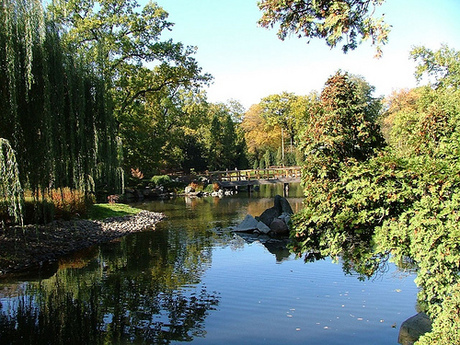Japanese garden
Wroclaw is full of nice surprises, and few are more pleasant to the casual tourist than stumbling this horticultural gem. The Japanese Garden owes its existence to the 1913 World Expo, when it was exhibited in the category of Artistic Gardening on the initiative of Count Fritz von Hochberg who commissioned Oriental landscape guru Mankichi Arai to do his thing. The garden fell into a sorry state after time but was restored in 1996 with funding from the Japanese Embassy in Warsaw. Open from April 'til October this miniature park, with its pagodas, cascades, oriental shrubs and narrow bridges, is a real treat.
In 1994, the city of Wroclaw decided to renovate it with the support of the Japanese embassy in Warsaw. Japanese professionals from the city of Nagoya worked at its renovation. Many new elements were added with respect to the original form. The result is exceptional and it is now a real masterpiece. Each element of the garden has its own meaning, that will not be understood by most novice visitors. Highlight of the garden are the two waterfalls. The male one with its rapid flow and the female one, which flows on three intermediate levels. The water from the two waterfalls flows towards a pond.
Ogrod Japonski (The Japanese Garden), Located in Szczytnicki Park close to Hala Stulecia (Centenary Hall) on Mickiewicza St. it is one of few traces of the World Exhibition in 1913 that remain in the park. Prepared and set up by a most notable Japan connoisseur and enthusiast, count Fritz von Hochberg, together with Japanese gardener Mankichi Arai, it was a jewel of the exhibition. However, many of the Japanese-style details were borrowed for the time of the exhibition and have since been removed.
In 1994 the Wroclaw authorities decided to restore the garden. The Japanese Embassy in Warsaw was asked for essential help. The request met keen interest from the Japanese Ambassador - Mr. Nagao Hyodo. In 1996 the restoration work started in cooperation with Japanese specialists from Nagoya (gardeners, stone arrangement architects, garden architects, etc.)
Thanks to the presence of Japanese specialists, the entire work corresponds to the style of Japanese garden art down to the fine details. Each element of the renewed garden has its place and meaning - which is often not visible to Europeans. The garden, bearing references to historical groundwork from 1913, acquired a lot of new elements that make its character really consistent with the rules of Japanese garden art.
The old cascade has been rebuilt into a "male" one, with fast flowing water curtain. Another cascade, "female", with slowly flowing water and two middle steps, has also been built. The water from both cascades goes to the lake which has a wandering shore line. There is an ornamental main gate to the garden, and a wide alley leading the visitors to the central and most attractive part of the garden - a beautiful bridge, covered with a decorative roof, joining the two banks of the lake. The garden has also acquired: a new island, stone lanterns and additional paths that allow visitors to approach the lake and admire the sights from the very bank of the stream. Another attraction in the Southern part of the garden, refers to Japanese homestead gardens with a Sukiya type house - that is a pavilion and cropped hedgerows and a fragment of a stone - grass garden. Whilst in previous years the garden had been Japanese by name only, now Wroclaw has gained a real piece of Japanese culture, something unique in this part of the world.




